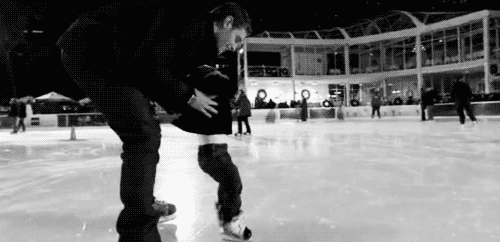2. Projectile Motion and Newton’s Third Law
Newton’s third law of motion states that for every action, there is an equal and opposite reaction. Skilled figure skaters propel themselves across the ice in controlled motions by taking advantage of Newton’s third law of motion.
At the start of the movement, when the skater pushes off against the ice, the ice pushes back. This is how the skaters are able to perform their T-stops at the end by using friction to push in the opposite direction of their motion.
This principal also applies to jumps. Figure skaters body becomes projectiles when they jump moving both vertically and horizontally. When a skater forcefully pushes down, the ice forcefully pushes up, launching the skater into the air to perform the jumps.
Moving across the ice, The skater’s horizontal velocity stays constant throughout the move compare to the vertical velocity (the skater goes up to a certain height and gravity pulls the skater back down) and you can notice that the forces are independent of each other.
The height and distance of a figure skating jumps are determined by a skater’s take-off velocity, take-off angle, and take-off position. A skater generates take off velocity by applying force against the ice. These two formulas allows to calculate jump height and distance from take-off velocity. (Vf = Vi + at), (d= Vit + 1/2 at^2)
It is very important to separate the object’s vertical take-off velocity from their horizontal take-off velocity because the gravity immediately starts slowing the skater’s vertical velocity, when the skater leaves the ice, but gravity has absolutely no effect on the skater’s horizontal motion since it is acting only in the vertical direction. When the skater is at the top of the jump, the vertical velocity is always zero.
The vertical and horizontal velocity can be calculated by applying these concepts:
If you are given :
- V to (take-off velocity)
θ (angle)
Then you can get :
- Vv (vertical velocity)
Vh (horizontal velocity)
By using sine and cosine :
Vv = V to sinθ
Vh = V to cosθ
These formulas come from the right triangle. (SOHCAHTOA)
Vertical Velocity— Vertical velocity is an indication of how quickly an object is falling or rising. Gravity immediately starts slowing the skater’s vertical velocity when the skater leaves the ice. Once gravity has slowed the skater’s upward velocity to zero, gravity then accelerates the skater back to the earth.
Question ) If Hannah’s take-off velocity is 10m/s, and the take-off angle is 45’, then what is Hannah’s vertical velocity?
Horizontal Velocity — Horizontal velocity is the speed of something flat on the ground like a car on the road. In order to jump straight up, the skater need to have some amount of vertical velocity and to move horizontally the skater need some amount of horizontal velocity.
Question) If Sue’s take-off velocity is 11m/s, and the take-off angle is 45’ then what is Sue’s horizontal velocity?
+ Question for the take-off velocity ) If Sarah’s horizontal velocity is 6 m/s, the vertical velocity is 6m/s, and the take-off angle is 45’, then what is Sarah’s take-off velocity?
Vertical Displacement
Vertical displacement is the height of the jump.
Take-off velocity is needed in order to calculate the vertical displacement. The easiest way to calculate is to first calculate the time it took to get from take-off to the top of the jump. Time up can be calculated from the equation Vf= Vi+at. Once the time-up have calculated, then we can get the vertical displacement from another equation D = Vit + 1/2 at^2.
Question) Ashley is performing lutz jump at the Nationals. Her take off velocity is 12m/s and the take-off angle is 45’. What’s the height of the lutz jump?

Horizontal Displacement
Horizontal displacement is the distance between the skater’s take-off point and the landing point.
Horizontal displacement is calculated similarly to vertical displacement. You need to know the time for the jump from take-off to landing to calculate the horizontal displacement.
In figure skating, the skaters take-off and land on a level surface, however, I’m gonna measure the distance from the centre of mass, not the surface of the ice. Thus, only if the centre of mass of the skater is at the same height at take-off and landing will the time up and time down be equal. The centre of mass depends on the position of the skater. The equation D = Vit + 1/2 at^2 will be used to calculate the Horizontal Displacement.
Question) Gracie is performing flip jump at the ISU competition. If Gracie’s take-off velocity is 12m/s, take-off angle is 43’, and the time-up is 0.69s. Calculate the horizontal displacement for Gracie’s entire jump.














